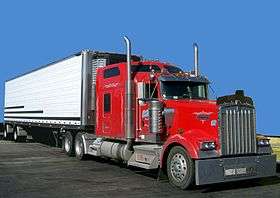Greyhound Lines
Greyhound Lines, Inc., usually shortened to Greyhound, is an intercity bus common carrier serving more than 3,800 destinations across North America. The company's first route began in Hibbing, Minnesota, in 1914 and the company adopted the Greyhound name in 1929. Since October 2007, Greyhound has been a subsidiary of British transportation company FirstGroup, but has been based in Dallas, Texas, since 1987. Greyhound and its sister companies in FirstGroup America are the largest motorcoach operators in the United States and Canada.[4]
 | |
.jpg) Greyhound Lines Prevost X3-45 in New York City in August 2009 | |
| Slogan | Go Greyhound and Leave the Driving to Us! |
|---|---|
| Parent | FirstGroup |
| Founded | 1914 by Carl Wickman Hibbing, Minnesota, U.S. |
| Headquarters | One Dallas Center 350 North Saint Paul Street Dallas, Texas, U.S. |
| Service area | United States, Canada, Mexico |
| Service type | Intercity coach service |
| Alliance | Trailways, Jefferson Lines, Indian Trails, Barons Bus, and others |
| Routes | 123 routes[1] (includes Greyhound Express routes) |
| Destinations | 2,700+[2] |
| Stations | 230 (company operated)[2] |
| Fleet | 1,700 motorcoaches[3] mostly MCI 102DL3, G4500, D4505, and Prevost X3-45 |
| Fuel type | Diesel |
| Chief executive | David Leach (CEO) |
| Website | www.greyhound.com |
History
1914–1930: Early years
.jpg)
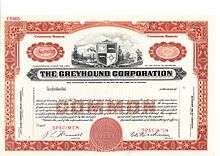
Carl Eric Wickman was born in Sweden in 1887. In 1905, he moved to the United States where he worked as a drill operator at a mine in Alice, Minnesota, until he was laid off in 1914. That same year, he became a Hupmobile salesman in Hibbing, Minnesota.[5] Although unsuccessful as a car salesman, Wickman used a seven-passenger car[6] to begin a bus service with Andy "Bus Andy" Anderson and C.A.A. "Arvid" Heed in 1914.[7] The fledgling company transported iron ore miners from Hibbing to Alice[6] at 15 cents a ride.[8]
In 1915, Wickman joined forces with Ralph Bogan, who was running a similar service from Hibbing to Duluth, Minnesota, to form the Mesaba Transportation Company.[9] The company made $8,000 in profit in its first year.
By the end of World War I in 1918, Wickman owned 18 buses and was making an annual profit of $40,000. In 1922, Wickman joined forces with Orville Caesar, the owner of Superior White Bus Lines.
The Greyhound name had its origins in the inaugural run of a route from Superior, Wisconsin to Wausau, Wisconsin. While passing through a small town, Ed Stone, the route's operator, saw the reflection of his 1920s era bus in a store window. The reflection reminded him of a greyhound dog, and he adopted that name for that segment of the Blue Goose Lines. The Greyhound name became popular across the bus network but only later gave its name to Greyhound Corporation. Stone later became General Sales Manager of Yellow Truck and Coach, a division of General Motors (GM), which built Greyhound buses.
Through most of the mid-1920s, the parent company was named Motor Transit Corporation. Wickman continued to expand it so that in 1928, the Greyhound system had a gross annual income of $6 million.[6] and was offering trips in places from California to New York. The first transcontinental bus trip was made in 1928 by competitor Yelloway-Pioneer System,[10] In 1929, Wickman purchased two West Coast operations, the Yelloway-Pioneer System[11] and the Pickwick Lines, creating a national intercity bus company.[12]
In 1929, Greyhound acquired additional interests in the Gray Line and part of the Colonial Motor Coach Company to form Eastern Greyhound Lines.[13] Greyhound also acquired an interest in Northland Transportation Company and renamed it Northland Greyhound Lines.[13]
1930–1945
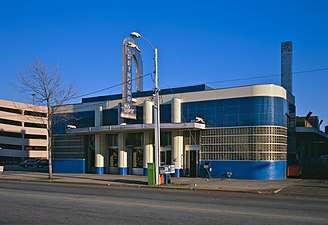
_Front_View.jpg)
By 1930, more than 100 bus lines had been consolidated into Motor Transit Corporation. Recognizing the need for a more memorable name, the partners of the Motor Transit Corporation changed its name to The Greyhound Corporation after the Greyhound name used by earlier bus lines.[14] In the same year, the company move from Duluth, Minnesota to Chicago, Illinois.[15]
Wickman's business suffered during the Great Depression, and by 1931 was over $1 million in debt. As the 1930s progressed and the economy improved, Greyhound began to prosper again. In 1934, intercity bus lines (of which Greyhound was the largest) carried approximately 400,000,000 passengers—nearly as many passengers as the Class I railroads. The film It Happened One Night (1934) — about an heiress (Claudette Colbert) traveling by Greyhound bus with a reporter (Clark Gable)[16] — has been credited by the company for spurring bus travel nationwide.[17] In 1935, national intercity bus ridership climbed 50% to 651,999,000 passengers, surpassing the volume of passengers carried by the Class I railroads for the first time.[18] In 1935 Wickman was able to announce record profits of $8 million. In 1936, already the largest bus carrier in the United States, Greyhound began taking delivery of 306 new buses.[19] In 1940 Canadian Greyhound Coaches Limited was acquired.
To accommodate the rapid growth in bus travel, Greyhound also built many new stations in the period between 1937 and 1945. To unify its brand image, it procured both buses and bus stations in the late Art Deco style known as Streamline Moderne[20] starting in 1937.[21]
For terminals, Greyhound retained such architects as W. S. Arrasmith and George D. Brown.[22] Notable examples of Streamline Moderne stations have been preserved in Blytheville, Arkansas, Cleveland, Ohio, Columbia, South Carolina, and Washington, D.C.
Greyhound worked with the Yellow Coach Manufacturing Company for its streamlined Series 700 buses, first for Series 719 prototypes in 1934, and from 1937 as the exclusive customer for Yellow's Series 743 bus (which Greyhound named the "Super Coach"). Greyhound bought a total of 1,256 buses between 1937 and 1939.[23]
By the outbreak of World War II, the company had 4,750 stations and nearly 10,000 employees.
1945–1983: Expansion, desegregation, and diversification
.jpg)
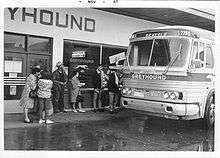
Wickman retired as president of the Greyhound Corporation in 1946 and was replaced by his long-time partner Orville S. Caesar.[24] Wickman died at the age of 66 in 1954.[25]
Greyhound commissioned noted industrial designer Raymond Loewy and General Motors to design several distinctive buses from the 1930s through the 1950s.[26][27][28] Loewy's first was the Yellow Coach PDG-4101, the Greyhound Silversides produced in 1940–1941. Production was suspended during World War II. When the "Silversides" buses resumed production in 1947, it was renamed GM PD 3751. PD 3751 production continued through 1948.[29] In 1954, the first of Greyhound's distinctive hump-backed buses was introduced. In 1944, Loewy had produced drawings for the GM GX-1, a full double-decker parlor bus with the first prototype built in 1953.[30] The Scenicruiser was designed Loewy and built by General Motors as model PD-4501. The front of the bus was markedly lower than its rear section.[31]
After World War II, and the building of the Interstate Highway System beginning in 1956, automobile travel became a preferred mode of travel in the United States.[32] This, combined with the increasing affordability of air travel, spelled trouble for Greyhound and other intercity bus carriers.[32]
In October 1953, Greyhound announced the acquisition of the Tennessee Coach Company's entire operation, and the negotiations for the Blue Ridge Lines, and its affiliate White Star Lines, that operated between Cleveland and the Mid Atlantic Seaboard.[33]
In 1955, the Interstate Commerce Commission ruled in the case of Keys v. Carolina Coach Co. that U.S. interstate bus operations, such as Greyhound's, could not be segregated by race.[34] In 1960, in the case of Boynton v. Virginia, the U.S. Supreme Court found that an African American had been wrongfully convicted for trespassing in a "whites only" terminal area.[35] In May 1961, civil rights activists organized interracial Freedom Rides as proof of the desegregation rulings. On May 14, a mob attacked a pair of buses (a Greyhound and a Trailways) traveling from Washington, D.C., to New Orleans, Louisiana, and slashed the Greyhound bus's tires.[36] Several miles outside of Anniston, Alabama, the mob forced the Greyhound bus to stop, broke its windows, and firebombed it.[37][38] The mob held the bus' doors shut, intending to burn the riders to death. Sources disagree, but either an exploding fuel tank[37] or an undercover state investigator brandishing a revolver[39] caused the mob to retreat. When the riders escaped the bus, the mob beat them, while warning shots fired into the air by highway patrolmen prevented them from being lynched.[37] Additional Freedom Riders were beaten by a mob at the Greyhound Station in Montgomery Alabama.
The Civil Rights Act of 1964's Title II and Title III broadened protections beyond federally regulated carriers such as Greyhound, to include non-discrimination in hotels, restaurants, and other public accommodations, as well as state and local government buildings.[40]
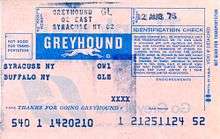
Later in the 1960s, Greyhound leadership saw a trend of declining ridership and began significant changes, including using the profitable bus operations to invest in other industries.[32] By the 1970s, Greyhound had moved its headquarters to Phoenix, Arizona and was a large and diversified company, with holdings in everything from the Armour meat-packing company (which in turn owned the popular Dial deodorant soap brand), acquired in 1970; Traveller's Express money orders, MCI and TMC bus manufacturing companies,[41] and even airliner leasing. Indeed, Greyhound had entered a time of great change, even beginning to hire African American and female drivers in the late seventies.[42]
In 1972, Greyhound introduced the special unlimited mileage Ameripass. The pass was initially marketed as offering "99 days for $99" (equal to $605.11 today) or, in other words, transportation to anywhere at any time for a dollar a day. For decades it was a popular choice for tourists on a budget who wanted to wander across the cities and towns of America.[43] Over time Greyhound raised the price of the pass, shortened its validity period and rebranded it as the Discovery Pass, before finally discontinuing it in 2012.[43]
Greyhound acquired Premier Cruise Line in 1984.[44] Between 1985 and 1993, Premier operated as the "Official Cruise Line of Walt Disney World" with onboard Disney characters.[45]
1983–2001: Consolidation, strikes, and bankruptcies
1983 Greyhound drivers' strike
In 1983, Greyhound operated a fleet of 3,800 buses and carried about 60 percent of the United States' intercity bus-travel market.[46] Starting November 2, 1983, Greyhound suffered a major and bitter drivers' strike[47][48] with one fatality in Zanesville, Ohio, when a replacement driver ran over a striking worker at a picket line.[49][50] A new contract was ratified December 19, and drivers returned to work the next day.[51]
1986–1990: Spin-off, merger, and first bankruptcy
By the time contract negotiations with the Amalgamated Transit Union (ATU) were due again at the end of 1986, the bus line was in the process of being sold to Dallas-based investors. By early 1987, Greyhound Lines had returned to being a stand-alone bus transportation company. Under CEO Fred Currey, a former executive of rival Continental Trailways, Greyhound's corporate headquarters relocated to Dallas, Texas.[52]
In February 1987, Greyhound Lines' new ownership and the ATU agreed on a new, 3-year contract.[53] In June 1987, Greyhound Lines acquired Trailways, Inc. (formerly Continental Trailways), the largest member of the rival National Trailways Bus System, effectively consolidating into a national bus service. Greyhound was required by the ICC, in their action approving the merger, to maintain coordinated schedules with other scheduled service operators in the U.S.[54]
Between 1987 and 1990, Greyhound Lines' former parent continued to be called The Greyhound Corporation, confusing passengers and investors alike.[55] The Greyhound Corporation retained Premier Cruise Lines and ten non-bus subsidiaries using the Greyhound name, such as Greyhound Leisure Services, Inc. (an operator of airport and cruise ship duty-free shops), and Greyhound Exhibits.[56] In March 1990, The Greyhound Corporation changed its name to Greyhound Dial Corporation. Because Greyhound Dial's switchboard continued to get questions from misdirected bus passengers,[55] it ultimately changed its name to The Dial Corporation in March 1991, to eliminate any association with bus travel.[57]
1990: Greyhound drivers' strike
In early 1990, the drivers' contract from 1987 expired at the end of its three-year term. In March, the ATU began its strike against Greyhound. The 1990 drivers' strike was similar in its bitterness to the strike of 1983, with violence against both strikers and their replacement workers. One striker in California was killed by a Greyhound bus driven by a strikebreaker,[58] and a shot was fired at a Greyhound bus.[59] While Greyhound CEO Fred Currey argued that "no American worth his salt negotiates with terrorists," ATU leader Edward M. Strait responded that management's failure to negotiate amounted to "putting the negotiations back into the hands of terrorists."[60] During the strike by its 6,300 drivers, Greyhound idled much of its fleet of 3,949 buses and cancelled 80% of its routes.[61] At the same time, Greyhound was having to contend with the rise of low-cost airlines like Southwest Airlines, which further reduced the market for long-distance inter-city bus transportation. Without the financial strength provided in the past by a parent company, the strike's lower revenues and higher costs for security and labor-law penalties caused Greyhound to file for bankruptcy in June 1990.[62] The strike would not be settled for 38 months under terms favorable to Greyhound. While the National Labor Relations Board (NLRB) had awarded damages for unfair labor practices to the strikers, this liability was discharged during bankruptcy reorganization.[58][63]
Early 1990s: Bankruptcy and antitrust cases
At the end of 1990, the company had $488 million in assets and $654 million in liabilities.[64] During bankruptcy, the company ultimately had to address claims for $142 million in back-pay for its striking drivers, and $384 million of pre-bankruptcy debts owed mostly to the investor group led by Fred G. Currey.[64]
According to the company, upon emergence from bankruptcy in August 1991, Greyhound had shrunk its overall workforce to 7,900 employees (from 12,000 pre-bankruptcy), and trimmed its fleet to 2,750 buses and 3,600 drivers.[64]
In August 1992, Greyhound canceled its bus terminal license (BTL) agreements with other carriers at 200 terminals, and imposed the requirement that Greyhound be the sole-seller of the tenant's bus tickets within a 25-mile radius of such a Greyhound terminal.[65] In 1995, the United States Department of Justice Antitrust Division brought suit to stop this practice, alleging that it was an illegal restraint of trade, bad for consumers, and reduced competition.[65] In February 1996, the United States won its case, and Greyhound agreed to permit its tenants to sell tickets nearby and permit its tenants to honor interline tickets with competitors.[66]
Greyhound's total revenues in 1994 were $616 million.[65]
2001: Trailways-Laidlaw mergers and bankruptcy
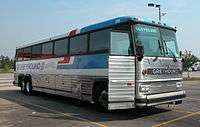
In the late 1990s, Greyhound Lines acquired two more members of the National Trailways Bus System. The company purchased Carolina Trailways in 1997,[67] followed by the intercity operations of Southeastern Trailways in 1998.[68] Following the acquisitions, most of the remaining members of the Trailways System began interlining cooperatively with Greyhound, discontinued their scheduled route services, diversified into charters and tours, or went out of business altogether.
On September 3, 1997, Burlington, Ontario-based transportation conglomerate Laidlaw Inc. announced it would buy Greyhound Canada Transportation ULC (Greyhound's Canadian operations) for US$72 million.[69]
In October 1998, Laidlaw announced it would acquire the U.S. operations of Greyhound Lines, Inc., including Carolina Trailways and other Greyhound affiliates, for about $470 million.[70] When the acquisition was completed in March 1999, all of Greyhound and much of Trailways had become wholly owned subsidiaries of Laidlaw.[71]
After incurring heavy losses through its investments in Greyhound Lines and other parts of its diversified business, Laidlaw Inc. filed for protection under both U.S. and Canadian bankruptcy laws in June 2001.[72]
2002–2007: Laidlaw years
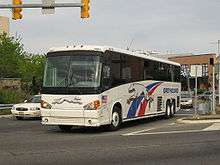
Naperville, Illinois-based Laidlaw International, Inc. listed its common shares on the New York Stock Exchange on February 10, 2003 and emerged from re-organization on June 23, 2003 as the successor to Laidlaw Inc.
After this bankruptcy filing, Greyhound dropped low-demand rural stops and started concentrating on dense, inter-metropolitan routes. It cut nearly 37 percent of its network.[73] In some rural areas local operators took over the old stops (often with government subsidies) particularly in the Plains states, parts of the upper Midwest (such as Wisconsin), and the Pacific Northwest.[74][75][76][77]
Starting in 1997, Greyhound had faced significant competition in the northeast from Chinatown bus lines.[78] By 2003, more than 250 buses, operated by competitors like Fung Wah and Lucky Star Bus were competing fiercely from curbsides in the Chinatowns of New York City, Boston, Philadelphia, and Washington, D.C.[78] When operating on inter-city routes, the Chinatown buses offered prices about 50% less than Greyhound's.[78] Between 1997 and 2007, Chinatown buses took 60% of Greyhound's market share in the northeast United States.[79]
2007–present: FirstGroup ownership
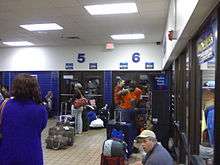
On February 7, 2007, British transport group FirstGroup purchased Laidlaw International for $3.6 billion. The deal closed on September 30, 2007[80] and the acquisition was completed on October 1, 2007.[81] Although FirstGroup's interest was primarily the school and transit bus operations of Laidlaw, FirstGroup decided to retain the Greyhound operations and in 2009 exported the brand back to the United Kingdom as Greyhound UK (unrelated bus operator Greyhound Motors from 1921 to 1972). In 2008, Greyhound's three regional bus operations (Carolina Trailways, based in Raleigh, N.C., Vermont Transit Lines of Burlington, Vermont, and Texas, New Mexico & Oklahoma Coaches of Lubbock, Texas ["T.N.M.&O."]) were consolidated into Greyhound Lines.[82]
As of 2014, Greyhound's 1,229 buses served over 3,800 destinations in North America, traveling 5.5 billion miles (8.8 billion km) on North America's roads.[83]
The "New Greyhound"
Almost immediately after acquiring the carrier, FirstGroup sought to improve Greyhound's image and create what it called the "New Greyhound" by refurbishing many terminals, expanding the fleet with new buses, refurbishing old buses, and retraining customer service staff. Greyhound also started a new advertising campaign with Butler, Shine, Stern & Partners aimed at attracting 18- to 24-year-olds and Hispanics to "The New Greyhound".[84]
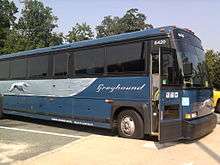
The "New Greyhound" also saw the introduction of a refreshed logo and a new navy blue and dark gray livery for buses, which was rolled out to the nationwide fleet over several years. As the older buses were repainted, they were also refurbished, receiving wireless Internet access, power outlets, and new leather seating with increased legroom.[85]
Addressing overbooking
During its ownership by Laidlaw, Greyhound had come under criticism for its ticket sale practices, specifically that although tickets had departure dates and times printed on them, Greyhound did not always stop sales after all the seats were purchased for each departure, a practice commonly known as overbooking. In periods of high demand, Greyhound added additional "sections" (buses), but the threshold required to trigger an additional section varied, often leaving passengers behind to wait for the next bus departure.[86]
Shortly after the sale to FirstGroup closed, Greyhound began a program in select markets, where riders could reserve a seat for an additional $5. However, only a limited number of seats could be reserved and the fee would have to be paid at the terminal's ticketing counter, even if the ticket was bought in advance online.[87]
The problem was further addressed in 2014, when Greyhound rolled out a new yield management computer system. With the new system, Greyhound is now able to more closely manage the number of tickets sold for each departure and dynamically adjust pricing based on sales.[88] Although the amount of overbooked buses has been sharply reduced with this new system, Greyhound still does not explicitly guarantee a seat to everyone with a ticket (except on Greyhound Express routes).[89]
Services launched since 2010
The next major change made by FirstGroup was the launch of a brand of premium bus routes called "Greyhound Express" in 2010. This came at the same time that competitor Megabus launched its third and fourth US hubs at Philadelphia and Washington D.C. and began to emphasize express services.[90] Greyhound's express routes make fewer stops between major cities (compared to regular Greyhound routes), use only newer model or refurbished buses, have guaranteed seating, and tickets start at $1.[91] Expansions in Greyhound's network and upgrades in its services in the early 2010s were at least partly a competitive response to Megabus.[92] In 2014, Greyhound CEO David S. Leach claimed a profit of $73 million on revenues of $990.6 million, and attributed the company's success to a mix of changing urban populations, less attractive driving options, and competition that was benefiting all carriers.[93]
In July 2015, the company announced that it would open terminals in Monterrey and Nuevo Laredo, Mexico, and begin service between the two cities with onward schedules to existing terminals in Texas. In so doing, Greyhound claimed to be the first American bus company to operate an intra-Mexican route.[94] In September 2015, Greyhound announced expanded service in Missouri and Kansas shortly after Megabus announced that it would be ending service to several cities and college campuses.[95]
Services
Greyhound operates 123 routes[1] serving over 2,700 destinations across the United States. Greyhound's scheduled services compete with the private automobile, low-cost airlines, Amtrak, and other intercity coach bus companies.
Greyhound Express
Greyhound Express is a low-cost express city-to-city service that makes either fewer stops or no stops compared to a traditional route. Fares start at $1 and seating is guaranteed since buses are not overbooked.[96] Greyhound Express was designed to directly compete with low-cost carriers like Megabus[97] and Chinatown bus lines.
The service began on September 28, 2010, with several routes radiating from New York to major cities in the Northeastern United States[98] and rapidly expanded to serve destinations in the Midwestern, Southern, and Southwestern United States. Currently the Greyhound Express network has expanded to serve 930 city pairs in nearly 120 markets, with further expansion planned.[99]
Greyhound Express routes are assigned new or refurbished buses that are equipped with Wi-Fi, power outlets, leather seats, and extra legroom. In many stations Greyhound Express customers can take advantage of dedicated waiting areas, separate from passengers traveling on other Greyhound services or other carriers. Some stations also board passengers onto Greyhound Express buses using numbers printed on tickets.[100] This number is assigned in the order in which the ticket was purchased, which means that passengers who bought their tickets earlier get to board the bus and choose their seats earlier.
Greyhound Connect
Greyhound Connect is a connector service that operates shorter routes to take passengers from stops in smaller, rural cities to stations in larger, urban cities. Buses are either from Greyhound's existing fleet or smaller, mid-sized buses (that are not equipped with a lavatory). Currently the Greyhound Connect service is offered in Alabama, Arizona, Arkansas, Colorado, Maryland, Missouri, Montana, North Carolina, Utah, and Vermont.[101] Some routes are operated using funds from the "Federal Formula Grant Program for Rural Areas" from the Federal Transit Administration.[102]
The cities served include (terminal cities in italics):[101]
Alabama: Alexander City, Alexandria, Anniston, Atmore, Bay Minette, Birmingham, Chattanooga (Tenn.), Childersburg, Columbus (Ga.), Dothan, Enterprise, Evergreen, Fort Payne, Gadsden, Mobile, Opelika, Pell City, Steele, Sylacauga, Talladega
Arizona: Cocopah Casino, Fortuna Foothills, Gadsden, San Luis, Somerton, Wellton, Yuma (along with stops at Arizona Western College and in Downtown Yuma and West Yuma)
Arkansas: Bald Knob, Jonesboro, Little Rock, Marked Tree, Newport, Searcy, West Memphis
Colorado: Craig, Denver (along with a stop at Denver's Greyhound station), Dinosaur, Granby, Hayden, Hot Sulphur Springs, Idaho Springs, Kremmling, Milner, Steamboat Springs, Winter Park
Maryland: Aberdeen, Baltimore, College Park, Edgewood, Elkton, Havre De Grace, Laurel, Washington (D.C.), White Marsh, Wilmington (Del.)
Missouri: Cabool, Columbia, Jefferson City, Houston, Huntsville, Kirksville, Macon, Mountain Grove, Ottumwa (Iowa), Rolla, Springfield
Montana: Arlee, Evaro, Kalispell, Lakeside, Missoula, Pablo, Polson, Ravalli, St. Ignatius, Whitefish
North Carolina: Ahoskie, Edenton, Elizabeth City, Goldsboro, Greenville, Jacksonville, Kinston, New Bern, Raleigh, Rocky Mount, Smithfield, Wallace, Washington, Williamston, Wilmington, Wilson
Utah: Duchesne, Fort Duchesne, Heber City, Myton, Park City, Roosevelt, Salt Lake City, Vernal
Vermont: Albany (N.Y.) (along with a stop at the airport), Burlington, Hanover (N.H.), Rutland, White River Junction
Greyhound Charter Services
Greyhound Charter Services arranges charter buses for customers using Greyhound's fleet of motorcoaches. Unlike many smaller charter operators, Greyhound is able to operate nationwide and offer one-way services, due to its network of routes.[103] In addition to providing transportation to individual groups, schools, and event operators, Greyhound Charter Services is also approved by the military and the government as a charter bus vendor.[104]
Greyhound Package Express
In addition to carrying passengers and their luggage, Greyhound buses also carry packages. Through Greyhound Package Express customers can book expedited cargo shipping door-to-door or station-to-station. The company says that shipping by bus offers a cost-effective alternative to other ground or air carriers for same-day delivery.[105]
Special routes
Lucky Streak
Lucky Streak is Greyhound's brand for routes between cities with casinos and other nearby cities. All fares were sold as open-ended round-trips, with passengers allowed to return to their origin at any time, until April 1, 2019.[106] On the Atlantic City routes, casinos offer special bonuses (gambling credit, room/dining discounts) to Lucky Streak passengers.[106]
There are currently three Lucky Streak routes:[107]
- Atlantic City: Baltimore, Brooklyn, New York City, Philadelphia, and Washington, D.C.
- Connecticut (Mohegan Sun & Foxwoods Casino): Boston, Bridgeport, New Haven, New York City, Providence, and Stamford
- Las Vegas: Anaheim, Barstow, Claremont, Compton, El Monte, Hollywood, Long Beach, Los Angeles, Phoenix, Riverside, San Bernardino, San Diego, Santa Ana, and Victorville
QuickLink
QuickLink is Greyhound's brand of commuter bus service that runs frequently during the peak weekday commuting hours.[108] In addition to one-way and round-trip tickets QuickLink offers monthly and 10-trip passes. Passes and tickets on QuickLink are flexible and passengers can board any bus with available seating. Currently the only QuickLink route is between Mt. Laurel, New Jersey and New York City.[108] Routes were formerly operated from Sacramento, California to the San Francisco Bay Area and Macon, Georgia to Atlanta.[109]
Other brands and partnerships
BoltBus
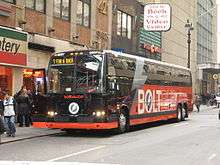
BoltBus is Greyhound's brand of non-stop and limited-stop, premium-level bus routes. Fares start as low as $1, with the lowest fares depending on how far in advance a trip is booked and demand for the trip, with fares increasing for trips booked closer to departure.[110][111] BoltBus uses newer model coaches that are equipped with Wi-Fi, power outlets, and leather seats with extra legroom.[112]
The first buses started running between Boston, New York City, and Washington, D.C. on March 27, 2008. In the Northeastern US, BoltBus was originally operated in partnership with Peter Pan Bus Lines,[113] but this arrangement ended on September 27, 2017, with Greyhound continuing the brand alone.[114]
BoltBus expanded to the West Coast in May 2012 with a route in the Pacific Northwest (between Vancouver, BC, Seattle, and Portland).[115][116] Service was expanded again in October 2013 with a route between the two largest metropolitan areas in California, Los Angeles and the San Francisco Bay Area (San Jose and Oakland).[117] A stop in the city of San Francisco was added in December 2013 along with a new route between Los Angeles and Las Vegas.[118]
Amtrak Thruway Motorcoach
Greyhound is one of the largest operators of Amtrak's Thruway Motorcoach service even though the two companies are competitors in some markets.[119] Amtrak issues rail passengers a ticket for a regularly scheduled Greyhound route that connects with their train, often with buses making a stop at the train station.[119] These Thruway Motorcoach routes allow Amtrak to serve passengers in areas without rail service and offer passengers in areas with rail service a wider selection of destinations.[120]
Security
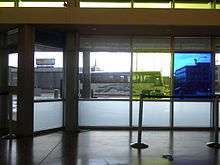
After the September 11, 2001 terrorist attacks, government scrutiny of train and airplane passengers substantially increased, but bus passengers are largely free of it. Baggage is seldom inspected, and cash customers do not require identification. Greyhound says that security wands have been deployed on buses, but they do not appear to be routinely used.
In February 2013, in partnership with DriveCam, Greyhound deployed video cameras across its entire fleet to increase safety and driver compliance by combining data and video analytics with real-time driver feedback and coaching.[121]
At some major Greyhound stations, passengers are subject to open-bag checks, ticket checks, and pat-downs with metal detectors.
In February 2020, the company reversed it position regarding unwarranted searches and notified the Department of Homeland Security that it no longer would allow unwarranted searches on its buses, in areas of terminals, company offices, or any area where a person needs a ticket for access.[122][123]
Current Fleet
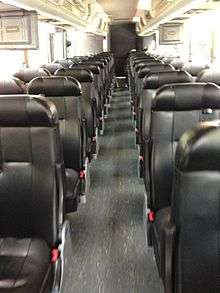
Greyhound operates 1,700 motorcoaches[3] produced mainly by Motor Coach Industries and Prevost.
In an effort to improve its public image, between 2007 and 2014, the company aggressively purchased new coaches and refurbished existing ones. As of 2016, the majority of Greyhound's fleet has the navy blue and grey "neoclassic" livery on the exterior, wireless internet access, leather seating, and 120-volt power outlets at most seats. Greyhound's coaches have one fewer row of seats than the industry standard, giving passengers additional legroom.[85] All buses purchased since 2009 have three-point seat belts installed.[124]
The majority of the Greyhound fleet consists of the following models:
| Manufacturer | Model | Image | Model Year | Quantity | Notes |
|---|---|---|---|---|---|
| Motor Coach Industries | 102DL3 | 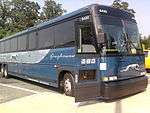 | 1996–2006 |
| |
| G4500 | 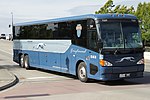 | 2001–2004 |
| ||
| D4505 | .jpg) | 2007–2017 |
| ||
| Prevost Car | X3-45 | 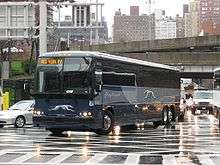 | 2009–present |
| |
| Champion Bus | Challenger | 2012–present |
|
Stations and stops
(This list covers stations within or adjacent to larger transportation centers.)
Greyhound serves over 2,700 destinations across America. There are 230 Greyhound operated stations in most major cities, where passengers can catch a bus and buy tickets.[2] All stations have Greyhound branding and are staffed by company representatives. Some stations stand alone, while others are a part of larger transportation centers with a Greyhound ticket counter and waiting area.
In small to mid-size cities Greyhound buses stop at either locations operated by an agent (like a convenience store or another business) or at a curbside stop. At most agent operated locations, the staff can also sell tickets.
Greyhound buses also stop at stations belonging to partner bus companies. At most of these locations, representatives are able to sell tickets for Greyhound routes.
Notable incidents and accidents
Below is a list of major incidents and accidents on Greyhound buses and buses of subsidiaries in the United States.
- August 4, 1952: In Greyhound's most deadly collision two Greyhound buses collided head-on with each other along the then-U.S. Route 81 near Waco, Texas. The fuel tanks of both buses then ruptured, bursting into flames. Of the 56 persons aboard both coaches, 28 were killed, including both drivers.[126][127]
- May 13, 1972: Near Bean Station, Tennessee, between Knoxville and Bristol, a Greyhound Scenicruiser on a scheduled trip from Memphis to New York City collided head-on with a tractor-trailer truck. The driver of the bus had begun to pass a car. Fourteen people, including both the bus and truck drivers, died. The National Transportation Safety Board determined that the cause of the crash was the Greyhound driver's overtaking maneuver and his failure to avoid the truck.[128]
- May 9, 1980: MV Summit Venture (A cargo ship; incident is in wiki of ship) collided with the Sunshine Skyway Bridge, near St. Petersburg, Florida, causing a part of the roadway to collapse and causing several vehicles, including a Greyhound bus, to fall into Tampa Bay. All 26 people aboard the bus died, as did nine others.[129]
- December 18, 1990: A Greyhound bus left Salt Lake City for Chicago and was caught in a driving snowstorm on I-80. Just short of the Wyoming border, the bus was hit by a semi-tractor trailer that had crossed the median heading in the opposite direction. The force of the collision tipped the bus onto its right side and it fell down a steep embankment. The bus slid for 150 feet and came to rest against a fence, about 35 feet below the eastbound lanes of I-80. Seven passengers were killed and more than 40 injured.[130]
- June 20, 1998: A Greyhound bus on a scheduled trip from New York City to Pittsburgh ran off a road near Burnt Cabins, Pennsylvania, and hit a truck parked in an emergency parking area. Six passengers and the driver died. The National Transportation Safety Board determined that the probable cause of the accident was the driver's use of a sedating antihistamine and driver fatigue, due to an irregular work-rest schedule.[131]
- October 3, 2001: At approximately 4:15 a.m. local time, a passenger, Damir Igric, assaulted the driver of his bus, attempting to slit his throat, and causing the bus to crash near Manchester, Tennessee, killing Igric himself and five other passengers and injuring 32 others. Since the incident occurred three weeks after the September 11 terrorist attacks, Greyhound temporarily suspended all schedules as soon as the company learned of the incident for fear that it may have been part of a larger co-ordinated attack. After investigation by the company and the FBI, it was confirmed that Igric had acted alone and service resumed later that afternoon.[132] After the incident, Greyhound bus stations increased security, though not nearly to the same level as airports or train stations.
- September 30, 2002: Arturo Martinez Tapia assaulted a Greyhound driver near Fresno, California, resulting in two passenger deaths after the bus then rolled off an embankment and crashed.[133] Following this attack, an aisle gate and driver's shield were installed on most Greyhound buses which prevent passengers from having direct contact with the driver when the bus is in motion, even if the aisle gate is forced open.
- January 23, 2014: Maquel Donyel Morris, 'who reportedly was hallucinating, screamed "Everybody's going to die," pummeled the driver and grabbed the steering wheel' of a bus traveling on Interstate 10 near Tonopah, Arizona, 50 miles (80 km) west of Phoenix. 24 passengers were injured, including 21 who were airlifted to nearby hospitals. Police credited the driver for keeping the bus upright and preventing it from crossing into oncoming traffic.[134]
- January 19, 2016: An overnight bus carrying 20 passengers that had departed from Los Angeles the previous night crashed on Highway 101 in San Jose, California, killing two and hospitalizing eight others.[135] Investigators have ruled out mechanical failure, leaving driver fatigue as the likely cause.[136]
- July 12, 2018: On a bus traveling from Columbus to Cincinnati three Colombian athletes on Comunidad el Oso Ultimate club claimed they were thrown off one of the buses for speaking Spanish. Greyhound indicated the players had become unruly due to them not being dropped off where they wanted to be dropped off, rather than their ticketed destination. The driver left them and all their luggage at a gas station. The players were traveling to the World Flying Disc Federation's World Ultimate Club Championships. They were picked up by the Ohio police soon after, and dropped off at their hotel in Cincinnati.[137]
- August 30, 2018: A Greyhound bus traveling from St. Louis to Los Angeles was involved in a collision with a semi-truck on Interstate 40 westbound near Thoreau, New Mexico. One of the tires on the eastbound truck blew out and caused the driver to lose control and cross the median, colliding with the bus. Of the 48 on board, eight lives, including the driver's, were lost, and several more sustained injuries.[138]
- February 3, 2020: One person was killed and five others were injured from a shooting on a bus heading from Los Angeles to San Francisco. The bus was stopped at a pit stop in Grapevine, California at the time of the incident.[139]
In popular culture
Films
- The 1934 film It Happened One Night shows the main character on a Greyhound bus from Florida to New York City.[140]
- The 1961 film Breakfast at Tiffany's shows the main character seeing her ex-husband off from New York City.[140]
- The 1969 film Midnight Cowboy shows the main character, in the final scene, holding his hustler friend on a New York City to Florida bus.[140]
- The 1974 film Harry and Tonto shows the main character, played by Art Carney, traveling cross-country with his cat aboard a Greyhound bus.[141]
- The 1988 film Cocktail sees the main character and his friends catching up to a Greyhound bus bound for New York City.
- The 1991 film Sleeping with the Enemy sees the main character escape from Cape Cod, Massachusetts, to Cedar Falls, Iowa, on a Greyhound bus.[142]
- The 1998 film Smoke Signals sees the main characters traveling from Coeur d'Alene, Idaho to Phoenix, Arizona via a Greyhound bus.
- The 1995 film Boys on the Side shows one of the main characters traveling to Pittsburgh on a Greyhound bus.
- The 1999 film Life has a scene of one of the main characters at a Greyhound bus station.
- The 2015 film Tomorrowland has several scenes featuring Greyhound, including a character traveling to the 1964 New York World's Fair on a historic bus (a 1969 GMC),[143] a Greyhound Glide-a-Ride trackless train on the World's Fair midway,[144][145] and the main character traveling on a Greyhound bus in 2015 (a MCI 102DL3) from Cape Canaveral, Florida to Houston, Texas. Greyhound also sponsored a sweepstakes tied in with the film, wrapped several Greyhound buses with imagery from the film, placed promotional items inside terminals, and sponsored the film's Los Angeles premier.[146]
Songs
- 1945 song, "Love on a Greyhound Bus", lyrics by Kay Thompson, Ralph Blane and music by George Stoll
- The Barry Mann/Cynthia Weil 1963 song "On Broadway" (remade most famously by The Drifters and later George Benson) mentions "I'll catch a Greyhound bus for home".[147]
- Chuck Berry rides a Greyhound bus from Norfolk, Virginia, to Birmingham, Alabama, in his 1964 song "Promised Land".
- Simon and Garfunkel referred to Greyhound Lines in their 1968 song "America".[140]
- Creedence Clearwater Revival mention Greyhound in their 1969 song, "Lodi".[148]
- Country singer Roy Clark sang about a romantic breakup in his 1970 song "Thank God and Greyhound."
- Folk singer-songwriter Harry Chapin song about taking the Greyhound in his 1972 song "Greyhound".
- The Allman Brothers Band referenced Greyhound Lines in their 1973 song "Ramblin' Man".[149]
- Country singer Waylon Jennings's 1973 song "Lonesome, On'ry and Mean" begins with the lyrics: "On a Greyhound bus/Lord I'm traveling this morning/I'm going to Shreveport and on down to New Orleans/Been driving these highways/Been doing things my way/It's been making me lonesome on'ry and mean."
- The Ian Hunter 1975 song "Once Bitten, Twice Shy"
- The 1976 song "The Killing of Georgie" by Rod Stewart states that Georgie leaves home for Manhattan on a Greyhound bus.
- In 1976, country singer Hoyt Axton released the song "An Old Greyhound" about his tour bus, a retired GMC PD-4501 Scenicruiser.
- Billy Joel's "New York State of Mind" from the Turnstiles album, released on May 19, 1976, refers to taking "a Greyhound on the Hudson River Line".[140]
- John Denver mentions riding a Greyhound bus at the beginning of "Wild Flowers In A Mason Jar (the Farm)", a song from the 1981 album Some Days Are Diamonds.
- In his song "Me and the Devil Blues", blues singer and guitarist Robert Johnson expresses a wish that his body be buried beside a road so that his "old evil spirit" can "catch a Greyhound bus and ride".[150]
- On indie rock band The Hang Ups' album So We Go, the last song is called "Greyhound Bus".
- American rock band The Mountain Goats references the narrator being "headed for the greyhound" in "See America Right" off of the album Tallahassee.[151]
- Kenny Chesney's song "Pirate Flag" describes the singer's escape from a small mountain town by taking a Greyhound bus to (what is implied to be) Key West, Florida.[152]
- Los Angeles–based rapper Skee-Lo recites Greyhound's advertising slogan in his 1995 hit single "I Wish" ("Cause if you don't want me around, see I go simple, I go easy, I go Greyhound").[153]
- The Cowboy Junkies' 1999 song "Leaving Normal" contains the lyric "Funny how the smell of a Greyhound bus now smells like a fresh start to me, and how the sound of the steel-belts on the blacktop is now the sound of breaking free".[154]
- Dexter Freebish's 2000 hit "Leaving Town" mentions Greyhound ("Take a drag and wait for the Greyhound, the world is your playground").[155]
- Country star Sara Evans' 2003 song "Backseat of a Greyhound Bus" describes a pregnant woman who escapes the confines of a small town and gives birth in a Greyhound bus.
- Death Cab for Cutie's 2005 song "Soul Meets Body" contains the lyric "Cause in my head there's a Greyhound station...".[156]
Other
- The Super Nintendo video game EarthBound, released in 1995 in North America, features a GreyHound Bus.[157]
- The musical Violet, like the short story "The Ugliest Pilgrim" on which it is based, follows the title character on a Greyhound Bus trip from Spruce Pine, North Carolina, to Tulsa, Oklahoma, and back.
- Monessen High School in Pennsylvania has a running greyhound mascot based on the Greyhound Line’s version.
See also
- Former operating subsidiaries
- Atlantic Greyhound Lines
- Capitol Greyhound Lines
- Dixie Greyhound Lines
- Florida Greyhound Lines
- Great Lakes Greyhound Lines
- Southeastern Greyhound Lines
- Teche Greyhound Lines
- Museums and Preserved Stations
- Freedom Rides Museum (Montgomery, Alabama)
- Greyhound Bus Museum (Hibbing, Minnesota)
- Old Greyhound Bus Station (Jackson, Mississippi) (private office)
- Old Greyhound Terminal (Washington, D.C.) (incorporated into building built on site)
References
- "Greyhound Timetables". Greyhound Lines. Archived from the original on December 27, 2014. Retrieved December 12, 2014.
- "Types of stations & stops". Archived from the original on April 6, 2016. Retrieved December 20, 2015.
With 2,700 destinations across America", "There are 230 Greyhound stations
- "Our Bus Fleet : Greyhound". greyhound.com. Retrieved February 14, 2018.
- Roman, Alex (January 5, 2015). "Fleets Growing, Business Strong for Motorcoach Top 50". Metro. Retrieved May 17, 2015.
- Lewis, Mary Beth. "Ten Best First Facts", in Car and Driver, 1/88, p.92.
- Lewis, p.92.
- "Tracing the Hound: The Minnesota Roots of the Greyhound Bus Corporation" (PDF). Retrieved September 21, 2013.
- "Greyhound Bus Museum". Greyhound Bus Museum. Archived from the original on September 21, 2013. Retrieved September 21, 2013.
- Walsh, Margaret (1985). "Tracing the Hound: The Minnesota Roots of The Greyhound Bus Corporation" (PDF). Minnesota Historical Society. pp. 310–320. Retrieved April 11, 2014.
- "The Yelloway Merger". Greyhound History. Retrieved July 17, 2020.
- "Business & Finance: Yelloway-Pioneer". Time. Time Magazine. September 24, 1928. Retrieved July 17, 2020.
- "Greyhound History-The Yelloway Merger". greyhoundhistory.com. Retrieved January 5, 2015.
- Walsh, Margaret. "Tracing the Hound: The Minnesota Roots of The Greyhound Bus Corporation" (PDF). Minnesota History (Winter 1985): 321. Retrieved April 11, 2014.
- "Greyhound History-The Name Change". greyhoundhistory.com. Retrieved January 5, 2015.
- "100 Years on a Dirty Dog: The History of Greyhound". mentalfloss.com. December 19, 2013. Retrieved July 18, 2019.
- Hall, Mordaunt. "It Happened One Night (1934): NYT Critics' Pick". The New York Times. Retrieved April 11, 2014.
- "Historical Timeline". Greyhound Lines. Archived from the original on February 16, 2014. Retrieved April 11, 2014.
- "Transport: Greyhound's Litter". Time (magazine). August 10, 1936. Retrieved April 11, 2014.
Class I railroads of the U. S. carried 445,995,000 passengers in 1935. Last week, the National Association of Motor Bus Operators announced that non-local bus lines had beaten this mark by carrying 651,999,000 passengers in 1935. An increase of almost 50% over 1934, it was the first time busses had handled more traffic than their biggest rivals.
- "Transport: Greyhound's Litter". Time (magazine). August 10, 1936. Retrieved April 11, 2014.
To keep pace with this new business, the largest U.S. bus line, Greyhound Corp., last week whelped the first 25 of a litter of 305 new busses, completely outmoding present standard equipment.
- Luther, Roger. "The Greyhound Runs Again: First Impressions at a Streamline Bus Station". Treasures of the Southern Tier. Binghamton Press & Sun-Bulletin. Archived from the original on May 22, 2013. Retrieved April 11, 2014.
- Wrenick, Frank E. (2011). Streamline era greyhound terminals : the architecture of w.s. arrasmith. Jefferson: Mcfarland. pp. 112–194. ISBN 978-0-7864-6445-6. Retrieved April 11, 2014.
The year 1937 was a pivotal one for Greyhound ... implemented its program to create a new corporate image, integrating architectural and vehicle designs, and commenced a massive program of building terminals that would be under its exclusive control and suit its needs. The buses and terminals were to be streamlined ...
- Wrenick, Frank E. (2007). The Streamline Era Greyhound Terminals: The Architecture of W.S. Arrasmith. McFarland. ISBN 9780786425501. Retrieved March 22, 2018.
- "Yellow Coach Part 2, Yellow Coach Mfg. Co., Yellow Truck and Coach, Yellow Bus, Greyhound Bus, Silversides, GMC Truck, CCKW, DUKW, General Motors". coachbuilt.com. Retrieved March 22, 2018.
Through a number of significant updates and modifications Dwight Austin's Model 719 coach evolved into the diesel-powered, air-conditioned Greyhound Super Coaches of the late thirties and 40s....1,256 Yellow Coach Model 743s were constructed through 1939
- Hampson, Philip (October 30, 1954). "The Road to Success". Chicago Tribune. Retrieved July 1, 2015.
- "Carl Wickman, Greyhound Bus Founder, Dead". Chicago Tribune. February 6, 1954. Retrieved July 1, 2015.
- "Patent USD113009S Design fob a motor coach". November 12, 1938. Retrieved April 10, 2018.
- "Patent USD129411S Design for a motor coach". June 26, 1941. Retrieved April 10, 2018.
- "Patent USD156445S Motor coach". December 29, 1948. Retrieved April 10, 2018.
- Johnson, Gary (1992). "1939 Yellow Coach 1210 parlor coach". Model Coach News. Lynnfield, MA (69): 5–6.
- "Double-deck coach". October 13, 1944. Retrieved April 10, 2018.
- Petrány, Máté. "The Greyhound Scenicruiser Was Filled With The American Dream". Jalopnik. Retrieved April 10, 2018.
- Belsky, Gary (December 19, 2013). "100 Years on a Dirty Dog: The History of Greyhound". Mental Floss. Retrieved August 30, 2015.
- Associated Press, "Greyhound Buys Stock Held by Railroads in Its Subsidiaries", San Bernardino Daily Sun, San Bernardino, California, Friday October 9, 1953, Volume LX, Number 34, page 6.
- Barnes, Catherine (1983). Journey from Jim Crow: The Desegregation of Southern Transit. New York: Columbia University Press. pp. 86–107.
- U.S. Supreme Court. "BOYNTON v. VIRGINIA, 364 U.S. 454 (1960)". FindLaw.com. Retrieved February 13, 2015.
- ""Freedom Riders," WGBH American Experience". PBS. Retrieved December 12, 2011.
- "Get on the Bus: The Freedom Riders of 1961". NPR. Retrieved July 30, 2008.
- Photo of a Greyhound bus firebombed by a mob in Anniston, Alabama. Retrieved February 1, 2010.
- Branch, Taylor (April 16, 2007). "Baptism on Wheels". Parting the Waters: America in the King Years 1954–63. pp. 412–50. ISBN 978-1-4165-5868-2.
- Sandoval-Strausz, A.K. (Spring 2005). "Travelers, Strangers, and Jim Crow: Law, Public Accommodations, and Civil Rights in America". Law and History Review. 23 (1): 53–94. doi:10.1017/s0738248000000055. JSTOR 30042844.
- On TMC: TMC - Transportation Manufacturing Corp. - 1973-1994 - Roswell, New Mexico - Subsidiary of MCI/Greyhound (Coachbuilt), as. Retrieved January 2, 2018.
- Jackson, Carlton. Hounds of the Road: a history of the Greyhound Bus Company. Bowling Green, Ohio: Bowling Green University Popular Press, 1984.
- Smith, Aaron Lake (December 20, 2013). "Riding the Dirty Dog". Vice. Retrieved August 1, 2015.
- Lazarus, George (May 30, 1989). "Greyhound Cruise Line Making Waves". Chicago Tribune. Retrieved June 30, 2015.
- Fritscher, Lisa. "How Disney Cruises Started". USA Today. Retrieved June 30, 2015.
he arrangement worked well for eight years, but in 1993 Premier announced that it was trading in on board Disney characters for a new license agreement with Warner Brothers ... Disney entered negotiations with both Carnival and Royal Caribbean in 1993 to replace the exclusive land and sea deal it once had with Premier, but when talks proved unsuccessful, Disney opted to create its own cruise line.
- "Strike Over Pay Cuts Halts Intercity Buses of Greyhound Lines". November 3, 1983. Retrieved April 11, 2014.
- Townsend, Ed (November 4, 1983). "Strike against Greyhound forces customers to leave driving to somebody else". The Christian Science Monitor. Retrieved April 9, 2014.
- Townsend, Ed (December 5, 1983). "Tentative settlement in Greyhound strike". The Christian Science Monitor. Retrieved April 9, 2014.
- Associated Press (December 6, 1983). "Greyhound Striker Killed by Training Bus". The New York Times. Retrieved April 10, 2014.
- "Ray Phillips and the 1983 Strike Ray Phillips and the 1983 Strike". December 31, 2011. Retrieved April 9, 2014.
Tragedy struck about 8:45 am. Lewis Harris reportedly ran a red light and drove through union pickets in a crosswalk at the intersection of U.S. 40 and Ohio 797. Ray Phillips was crushed.
- The Associated press (December 20, 1983). "Greyhound Strikers Accept Pact; Immediate Return to Work Urged". The New York Times. Archived from the original on April 17, 2014. Retrieved June 18, 2014.
- "Historical Timeline". Greyhound Lines. Archived from the original on February 16, 2014. Retrieved June 30, 2015.
1987 The Greyhound Corporation divests its U.S. bus operations. The new company, Greyhound Lines, Inc., establishes its headquarters in Dallas. Fred Currey is the company's new chief executive. Greyhound Lines purchases Trailways, Inc., establishing Greyhound as the largest nationwide intercity bus transportation company.
- Associated Press (February 4, 1987). "Union, Buyers of Greyhound Settle Contract". Los Angeles Times. Retrieved April 9, 2014.
- Thomas C. Hayes (June 20, 1987). "Greyhound in Deal for Trailways". The New York Times. Retrieved January 6, 2012.
- "The Dial Corp. History". Funding Universe. Retrieved June 30, 2015.
To minimize confusion for its investors and consumers by distinguishing the company from the Greyhound bus line it had sold off three years before, the company changed its name to Greyhound Dial in March 1990. At the time Teets decided to retain "Greyhound" as part of the company's new name in order to reflect the ten subsidiaries the company still owned that carried the Greyhound name, such as Greyhound Exhibit group. Within the year, however, when Greyhound Dial switchboard operators were still receiving numerous calls regarding bus routes and fares, management decided to make the message clearer still by renaming the company The Dial Corp.
- "Viad Corp Sells Greyhound Leisure Services, Inc. to Cruise Line". Business Wire. September 17, 1998. Retrieved June 30, 2015.
- Associated Press (March 6, 1991). "COMPANY NEWS; Greyhound Dial Is Now Dial Corp". The New York Times. Retrieved June 30, 2015.
The Greyhound Dial Corporation has changed its name to the Dial Corporation to eliminate any association with bus travel.
- "THE GREAT GREYHOUND STRIKES". Angelfire.com. Retrieved January 21, 2015.
- Times Wire Services (March 21, 1990). "P.M. Briefing: Greyhound Bus Fired on in Va". Los Angeles Times. Retrieved April 10, 2014.
- Baker, Bob (April 8, 1990). "Greyhound May Go Way of Eastern : Labor: Financial collapse and hope of a better deal from a new bus company owner could be strategy if strike takes path of the troubled airline". Los Angeles Times. p. 34A.
- LaMendola, Bob (March 3, 1990). "Greyhound Bust Strike at Nation's Biggest Bus Line Causes Delays, Drives Off Customers". Sun-Sentinel (South Florida, USA). Retrieved April 11, 2014.
- Baker, Bob (June 5, 1990). "Strikebound Greyhound Lines Files for Chapter 11". Los Angeles Times. Retrieved June 18, 2014.
The 13-week-old Greyhound bus strike, already mired in litigation and anger, grew even more complex Monday when financially ailing Greyhound Lines Inc. filed for protection from its creditors under Chapter 11 of the U.S. Bankruptcy Code.
- "Greyhound Bus Drivers End 3-Year Strike With New Pact". The New York Times. May 9, 1993. Retrieved January 21, 2015.
- Inquirer Wire Services (August 31, 1991). "Judge Approves Greyhound Plan To Reorganize". Philadelphia Inquirer. Retrieved April 18, 2014.
- "Complaint: USA v Greyhound Lines, Inc". Antitrust Division website. U.S. Department of Justice. Retrieved April 18, 2014.
- "Final Judgment: USA vs Greyhound Lines, Inc". Antitrust Division website. U.S. Department of Justice. Retrieved April 18, 2014.
- "Greyhound To Buy Carolina Trailways". March 10, 1997. Retrieved September 21, 2013.
- "Greyhound Acquires Southeastern Trailways Business". Thefreelibrary.com. July 6, 1998. Retrieved September 21, 2013.
- "Laidlaw Plans to Buy Greyhound Canada for $72 million". The New York Times. September 3, 1997. Retrieved April 10, 2014.
- Times Wire Services (October 20, 1998). "Laidlaw to Acquire Greyhound Lines". Los Angeles Times. Retrieved April 10, 2014.
- "Greyhound Stockholders Approve Merger With Laidlaw, Inc" (Press release). Greyhound Lines, Inc. March 16, 1999. Archived from the original on April 13, 2014. Retrieved April 10, 2014.
At a special meeting of the stockholders of Greyhound Lines, Inc., held this morning, Greyhound's merger with Laidlaw Inc. was approved. The transaction is effective today and as a result, Greyhound has become a wholly owned subsidiary of Laidlaw Inc.
- Reuters (June 29, 2001). "Laidlaw Units File for Bankruptcy Protection". Los Angeles Times. Retrieved April 10, 2014.
- "Greyhound: 100 years old and acting younger than ever". The Washington Post. Retrieved January 21, 2015.
- "USATODAY.com - Some left in lurch as Greyhound cuts stops". USA Today. Retrieved January 21, 2015.
- "As Greyhound Cuts Back, The Middle of Nowhere Means Going Nowhere". The New York Times. September 6, 2004. Retrieved January 21, 2015.
- "The Greyhound doesn't stop here anymore". Post-gazette.com. November 13, 2005. Retrieved March 15, 2015.
- "Doghouse on Wheels". Archived from the original on August 22, 2016. Retrieved June 1, 2016., Emily Lambert, Forbes, January 31, 2005
- O'Shaughnessy, Patrice (June 16, 2003). "Chinatown Bus War Fuels Probe: Slain businessman tied to mob, cops say". Daily News. New York. Retrieved April 17, 2014.
- Schliefer, Theodore (August 8, 2013). "Bus travel is picking up, aided by discount operators". Philadelphia Inquirer. Retrieved August 25, 2013.
- "exv99w1". Sec.gov. Retrieved January 21, 2015.
- "FIRSTGROUP COMPLETES ACQUISITION OF LAIDLAW" (Press release). October 1, 2007. Archived from the original on January 21, 2015. Retrieved January 17, 2015.
- Marta, Suzanne (March 5, 2008). "Greyhound to consolidate subsidiaries". McClatchy - Tribune Business News; Washington. Washington, United States, Washington. ProQuest 465871499.
- Sachs, Andrea (July 3, 2014). "Greyhound: 100 years old and acting younger than ever". The Washington Post.
- "Greyhound Gets A Makeover". CBS News. November 12, 2007. Retrieved November 12, 2007.
- "Greyhound New Buses". Greyhound. Archived from the original on October 16, 2013. Retrieved October 18, 2013.
- Overstreet, Sarah (June 16, 2006). "Even with a ticket, relying on Greyhound bus can be a gamble". Springfield News-Leader. Archived from the original on January 21, 2015. Retrieved January 21, 2015.
- "Greyhound Introduces Reserved Seating Program" (Press release). November 12, 2007. Archived from the original on October 19, 2015. Retrieved June 15, 2015.
- "Greyhound Modernizes IT Infrastructure to Provide More Pricing Options for Consumers and Optimize Operations" (Press release). December 9, 2014. Archived from the original on February 19, 2015. Retrieved January 5, 2015.
- Schwieterman, Joseph P.; Antolin, Brian; Scott, Gary; Sellers, Martin (January 12, 2015), Adding on Amenities, Broadening the Base: 2014 Year-in-Review of Intercity Bus Service in the United States (PDF), DePaul University Chaddick Institute for Metropolitan Development, p. 3, retrieved January 17, 2015
- Austen, Ben (April 7, 2011). "The Megabus Effect". Bloomberg Business. Bloomberg LLC. Retrieved October 4, 2015.
- "Greyhound Introduces New Express Service" (Press release). November 12, 2010. Archived from the original on April 13, 2014. Retrieved April 11, 2014.
- McManis, Sam (November 10, 2013). "Long-distance buses are cheap and surprisingly attractive options for travel". The Sacramento Bee. Retrieved October 5, 2015.
... there now is heated competition in the long-distance bus industry. The recent rise of Megabus.com, a British company featuring bright blue and orange two-decker coaches that began service in Sacramento in 2012, has prompted Greyhound to expand and upgrade its service. The result is a boon to travelers.
- Automotive Writer (June 7, 2014). "Greyhound starting to get its stride back". The Dallas Morning News. The Dallas Morning News Inc. Retrieved October 5, 2015.
But Leach said the competition should benefit all the carriers because it calls attention to buses. "We're the ones with the iconic brand and the established network," he said. "But the fact that Megabus is coming in just gets buses in general out front and at a time when you've got all these great changes going on."
- Forgione, Mary (July 16, 2015). "Greyhound starts bus service in Mexico, with connecting routes to Texas". Los Angeles Times. Retrieved September 10, 2015.
- Hudnall, David (September 24, 2015). "Greyhound to expand Kansas City and Columbia services in light of Megabus' departure". The Ptich. Retrieved October 5, 2015.
- "Greyhound Express Perks and Benefits". Archived from the original on December 31, 2014. Retrieved December 31, 2014.
- Brock, Katherine Cromer (October 18, 2012). "Greyhound Express adds cities to Houston route". Dallas Business Journal. Retrieved April 2, 2013.
- "Greyhound and Peter Pan Bus Lines Launch Express Service in the Northeast ; New Service Offers More Schedules, Faster Trips, Lower Fares and Easy-to-Use Regional Website" (Press release). Greyhound. September 21, 2010. Archived from the original on October 5, 2015. Retrieved April 22, 2015.
- FirstGroup (Summer 2014). "Greyhound factsheet" (PDF). Archived from the original (PDF) on February 13, 2015. Retrieved April 22, 2015.
- "Grreyhound Express FAQ". Archived from the original on December 31, 2014. Retrieved December 31, 2014.
- "Greyhound Connect". Greyhound.com. Archived from the original on December 31, 2014. Retrieved January 21, 2015.
- "Greyhound to add Mo. to Iowa round trip service". METRO Magazine.
- "Greyhound Charter Services". Greyhound.com. Archived from the original on January 2, 2015. Retrieved January 2, 2015.
- "Greyhound Charter Services - Military and Government". Greyhound.com. Archived from the original on January 2, 2015. Retrieved January 2, 2015.
- "About Package Express". Shipgreyhound.com. Archived from the original on February 6, 2015. Retrieved January 21, 2015.
- "Greyhound Lucky Streak". Greyhound Lines. Retrieved September 11, 2019.
- "Greyhound Services & Routes". Greyhound.com. Archived from the original on November 6, 2014. Retrieved January 2, 2015.
- "QuickLink". Greyhound.com. Archived from the original on October 25, 2014. Retrieved January 2, 2015.
- Lentzsch, Craig (March–April 2003). "Making the Connections" (PDF). TR News (225). Transportation Research Board of the National Research Council. p. 32. Retrieved January 2, 2015.
Greyhound's Quicklink brand of commuter service operates from Mt. Laurel, New Jersey, to New York City, and from Northeast Sacramento, California, to the Bay Area. Most recently, Quicklink began serving Macon, Georgia, to Atlanta.
- Anita Hamilton (June 6, 2008). "Beating $4 Gas with a $1 Bus". Retrieved June 8, 2008.
- "BoltBus - FAQ". Retrieved April 10, 2014.
Every schedule will have at least one $1.00 ticket. The $1.00 ticket will be sold at random and generally within the first handful of seats sold. The earlier you book your ticket, the greater your odds are of grabbing a seat for a buck.
- "BoltBus - FAQ". Retrieved April 10, 2014.
- "BoltBus - FAQ". Retrieved April 10, 2014.
BoltBus is owned by Greyhound Lines, Inc. and is operated in the Northeast region in partnership with Peter Pan Bus Lines, Inc. of Springfield, MA.
- "Greyhound, Peter Pan will split up and be rivals again - The Boston Globe". Boston Globe. Retrieved September 14, 2017.
- Sokolowsky, Jennifer (April 30, 2012). "BoltBus to offer $1 fares between Seattle, Portland". Puget Sound Business Journal. Retrieved April 11, 2014.
- Nolasco, Joanna (May 15, 2012). "BoltBus to launch new Seattle-Vancouver, B.C., service". Puget Sound Business Journal. Retrieved April 11, 2014.
- "BoltBus To Launch Service in California on Oct. 31". PR Newswire. October 15, 2013. Retrieved April 10, 2014.
- "BoltBus Expands From Los Angeles; Adds Las Vegas, San Francisco Service". PR Newswire. December 10, 2013. Retrieved April 10, 2014.
- "About Greyhound". Archived from the original on February 14, 2014. Retrieved April 11, 2014.
Amtrak passengers use Greyhound to make connections to cities not served by rail on Amtrak Thruway service by purchasing a ticket for the bus connection from Amtrak in conjunction with the purchase of their rail ticket.
- "Amtrak Thruway Connecting Services Multiply Your Travel Destinations". Retrieved April 11, 2014.
- Prabu, Karthick (February 22, 2013). "New TSA Pre-check airports, Greyhound goes Big Brother and more travel tech news". Phocuswire.
- Johnson, Gene, Greyhound to stop allowing immigration checks on buses, The Associated Press, February 21, 2020
- Greyhound bars immigration sweeps, Axios, February 22, 2020
- "Greyhound Applauds National Highway Traffic Safety Administration for Requiring Seat Belts on all New Motorcoaches Starting in 2016" (Press release). Greyhound Lines. November 20, 2013. Archived from the original on October 19, 2015. Retrieved June 17, 2014.
- "Greyhound Facts And Figures > Fleet". Greyhound. Archived from the original on February 14, 2014. Retrieved February 22, 2014.
There are 769 102DL3s in the Greyhound fleet, with nearly 75% equipped with wheel-chair lifts.
- Jackson, Carlton (1984). Hounds of the Road. Books.ggogle.com. ISBN 9780879722715. Retrieved January 21, 2015.
- "My Turn: He's still walking tall, and grateful to be alive". Dailybreeze.com. Retrieved January 21, 2015.
- "GREYHOUND BUS/MALONE FREIGHT LINE, INC. TRUCK COLLISION". National Transportation Safety Board. October 25, 1973. Retrieved June 15, 2015.
- Jean Heller (May 7, 2000). "The Day Skyway Fell: May 9, 1980". St. Petersburg Times. Retrieved August 30, 2015.
- "7 Killed in Collision Of a Greyhound Bus And Trucks in Utah". The New York Times. Associated Press. December 19, 1990. Retrieved August 31, 2015.
- "National Transportation Safety Board. 2000. Greyhound Motorcoach Run-off-the-Road Accident, Burnt Cabins, Pennsylvania, June 20, 1998" (PDF). National Transportation Safety Board. January 5, 2000. Retrieved June 15, 2015.
- "Breaking News, U.S., World, Weather, Entertainment & Video News - CNN". CNN. February 19, 2014. Archived from the original on May 30, 2010. Retrieved January 21, 2015.
- "Americas - Knife attack on California bus". BBC. Retrieved January 21, 2015.
- TANG, TERRY; DAVENPORT, PAUL (January 23, 2014). "Police: 24 hurt after passenger attacks bus driver". Associated Press. Retrieved January 31, 2014.
- "GREYHOUND BUS DEPARTS FROM LA, CRASHES IN SAN JOSE; 2 DEAD, 8 HOSPITALIZED". abc7.com. ABC News. January 19, 2016. Retrieved February 29, 2016.
- Early, David (January 21, 2016). "Mechanical failure ruled out in Greyhound bus crash in San Jose". San Jose Mercury News. Retrieved February 29, 2016.
- "Colombian ultimate Frisbee players headed to Cincinnati were kicked off Greyhound for speaking Spanish. Greyhound says otherwise". Cincinnati.com. Retrieved July 14, 2018.
- "What we know about deadly Greyhound bus crash". koat.com. Retrieved September 1, 2018.
- "6 people shot on Greyhound bus in California". MSN.com. MSN. Retrieved February 3, 2020.
- "Greyhound buses: in song and on screen". The Guardian. Retrieved January 21, 2015.
- Hollmann, Walter L. (May 2, 2011). "The Men In Charge: Best Actor, 1974". Retrieved October 5, 2015.
When I think about what I like about Harry and Tonto, I think about his forcing a Greyhound bus to stop because his cat needs to pee.
- Hicks, Chris (February 8, 1991). "Film review: Sleeping With the Enemy". Deseret News. Retrieved October 5, 2015.
- Wakefield, Jonny (June 26, 2015). "A tale of two buses". Dawson Creek Mirror. Retrieved July 31, 2017.
- "1964 New York World's Fair 1965 - Artifacts - World's Fair Legacies - Page Five". nywf64.com. Retrieved July 31, 2017.
- "Greyhound Escorter in "Tomorrowland"". IMCDb.org.
- Greyhound Lines, Inc. (April 29, 2015). "Greyhound Announces "Next Stop: Tomorrowland" Sweepstakes And Promotion". PR Newswire. Retrieved July 31, 2017.
- "On Broadway Lyrics". MetroLyrics. Retrieved October 5, 2015.
- "Lodi Lyrics". MetroLyrics. Retrieved October 5, 2015.
- "Ramblin' Man Lyrics by The Allman Brothers". stlyrics.com. Retrieved November 10, 2012.
- "Me And The Devil Blues (take 1) Lyrics". MetroLyrics. Retrieved October 5, 2015.
- "See America Right Lyrics". MetroLyrics. Retrieved October 5, 2015.
- "Pirate Flag". MetroLyrics. Retrieved October 5, 2015.
- "I Wish Lyrics". MetroLyrics. Retrieved October 5, 2015.
- "Cowboy Junkies Rarities, B-Sides and Slow, Sad Waltzes Lyrics". junkiesfan.com. Retrieved February 18, 2018.
- "Leaving Town Lyrics". MetroLyrics. Retrieved October 5, 2015.
- "DEATH CAB FOR CUTIE LYRICS - Soul Meets Body". metrolyrics.com. Retrieved April 20, 2016.
- "EarthBound for Wii U". Nintendo of America. July 18, 2013. Retrieved June 1, 2019.
Further reading
- Schisgall, Oscar (1985). The Greyhound Story: From Hibbing to everywhere. Chicago: J.G. Ferguson Publishing Company (Doubleday). ISBN 0-385-19690-3.
- Margolis, Richard J., "Sic paratransit gloria omnibus. (decline of rural bus service by Greyhound has led to services provided by vans and minibuses)", The New Leader, June 3, 1985.
External links
| Wikimedia Commons has media related to Greyhound Lines. |
- Greyhound Lines home page
- Greyhound Canada
- Greyhound Mexico
- Current Greyhound Lines timetables
- Greyhound listing of both current and archived schedule changes, updated map of Greyhound routes, and current and archived timetables, along with contact info
- Greyhound Bus Museum, in Hibbing, Minnesota
